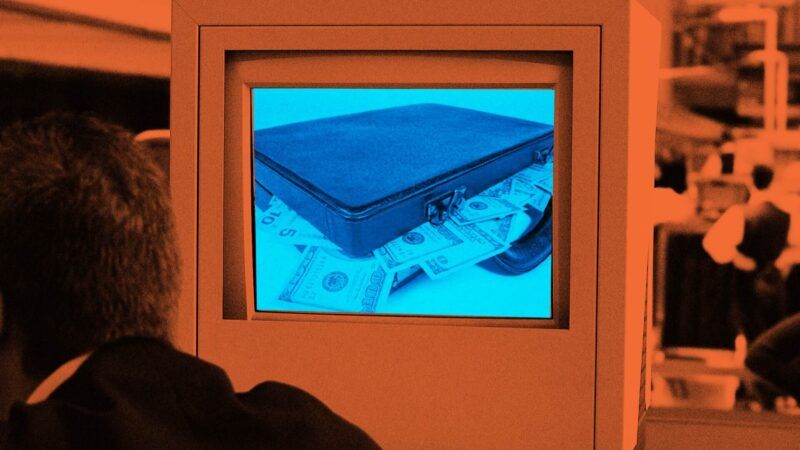TSA Owes $100 Million for Patent Infringement on Plastic Security Bins
When overly broad patents and the TSA clash, there are no heroes.

In an August opinion released on Friday, the U.S. Court of Federal Claims sided against the Transportation Security Administration (TSA) in a patent suit that could cost taxpayers over $100 million.
Anybody who has flown commercially is familiar with the dreaded checkpoint process: taking off your shoes, deciding between the body scanner or a pat-down, cramming all of your physical belongings into a plastic bin and shoving it through an X-ray machine.
As it turns out, according to the court's decision, that last process is more complicated than one might assume. The prevailing company, SecurityPoint Holdings, claimed that the TSA's system of stackable trays, moved across a conveyor belt before being transported back to the beginning of the line, illegally infringes upon a design patented by the company's founder, Joseph T. Ambrefe Jr., more than 15 years ago.
That original design, submitted in 2002 and approved by the U.S. Patent and Trademark Office in 2005, was titled "advertising trays for security screening," and it described a "system and device for use in a security area, and more particularly, a rack system and holding device for placing various objects that are processed through a security area." There are renderings of the trays from all angles, plus an overhead diagram of the system itself.
In the original lawsuit filed in 2011, SecurityPoint Holdings (now known as SecurityPoint Media) claimed that in 2006, after the patent had been granted, the TSA's internal documentation warned that there was "no single TSA standard bin return system," and that the process of manually picking up and carrying them back "is known to be a significant injury risk and should be eliminated if possible." By 2009, however, an updated version of the same internal guide spelled out a process for bin return, utilizing "bin carts."
And…that's it. That is the extent of the evidence presented. SecurityPoint cites the "method" listed in the original patent filing as proof of infringement. The steps, listed on the final page of the filing, essentially boil down to putting a cart full of bins near the entrance of the belt; putting an empty cart near the end of the belt; and switching carts when the first bin is empty and the second bin is full.
In relief, SecurityPoint asked for damages, interest, and attorney's fees, which at one point during the trial totaled $618 million. While the TSA countered with a lump sum payout of $12.6 million, Judge Eric Bruggink handed down a judgment of more than $103 million against the TSA—a loss that will, of course, be absorbed by taxpayers.
In fairness to SecurityPoint and founder Ambrefe, trial testimony revealed that the TSA had in fact initially agreed to test out the system in 2005. Ambrefe offered the license to use his patented method, in exchange for the exclusive right to advertise on the trays (in fact, the company currently offers graphical signage and advertising, including in the bottom of airport security trays). The TSA admitted that despite successful tests, it declined Ambrefe's offer, yet used a variation on his method in certain airports at least as far back as 2008. Indeed, the judge stipulated that SecurityPoint could be entitled to further compensation through earned interest, based on the amount of time since the lawsuit was first filed.
Ambrefe may be completely sincere—indeed, every patent he has filed somehow pertains to the airport security screening process—but unfortunately, this case has all the hallmarks of a patent troll.
Typically, a patent troll is an individual or company that buys up vaguely-worded patents and files* patent infringement lawsuits against the owners or marketers of existing products or services that even vaguely resemble what the patent covers. Often, megacorporations will buy up dying businesses for access to their portfolios of patents—not out of a desire to innovate, but as a defense against competitors' lawsuits. Unlike most patent trolls, Ambrefe did in fact invent and patent the intellectual property at issue in his case, but the criteria the court used to find in his favor was every bit as strained.
In fact, the Electronic Frontier Foundation (EFF) filed an amicus brief in 2016 after the court affirmed the validity of SecurityPoint's original patent, making the claim that it should have been rendered invalid under the doctrine of obviousness, in which an invention may not be patented if it "would have been obvious to a person having ordinary skill in the relevant art at the time the patent was sought." While the judge was ultimately not swayed, the fact remains that the "technology" at issue was a pair of rolling carts and a series of stackable bins, and instruction to rotate their positions at appropriate intervals.
The EFF did concede that although SecurityPoint "had developed a good system for managing trays and carts within the confined space of an airport security checkpoint," the claims made within the suit "are far broader than any specific solution," and risk crowding out any future inventors whose creations are different, though not quite different enough. Laws regarding intellectual property are designed to stimulate people's creativity by incentivizing innovation, namely through the financial reward of being the only one who is allowed to sell your product. Interpreted too broadly, however, those same laws can create headaches for other innovators, or even people who behave in a manner too similar to a patented methodology and risk running afoul. The TSA may indeed have erred by not compensating Ambrefe at the outset, but that mistake should not cost taxpayers $100 million.
*CORRECTION: A previous version of this article referred to copyright infringement rather than patent infringement.


Show Comments (39)